

Where Qualitative Meets Quantitative Data w/ Delve co-founders LaiYee Ho and Alex Limpaecher. Our interview on ThisAnthroLife with Adam Gamwell After being a listener of ThisAnthroLife for quite a while, I was lucky enough to meet the host, Adam Gamwell at the Business Anthropology Summit.

We decided to meet up last July, along with my co-founder Alex, to geek out on qualitative research on the ThisAnthroLife podcast. I’m reposting it here from the ThisAnthroLife website. You can listen to the episode here on ThisAnthroLife Podcast. In this episode Adam Gamwell talks with Alex Limpaecher and LaiYee Ho, co-Founders of Delve. Publications and Outputs : Timescapes Archive. Timescapes Overview Documents Timescapes Working Paper Series Briefing Papers – (2011) Policy Briefing Paper 1 – My Place in Society: young people’s perspectives [PDF: 1.14MB]Policy Briefing Paper 2 – Following Young Fathers: the lived experience of teenage parenting over time [PDF: 1.73MB]Policy Briefing Paper 3 – New Mothers in Contemporary Times [PDF: 3.07MB]Policy Briefing Paper 4 – Strengthening Men’s Involvement in Fathering: Opportunities and Challenges [PDF: 1.68MB]Policy Briefing Paper 5 – Children and Working Parents: experiences of managing time, place and caring [PDF: 2.34MB]Policy Briefing Paper 6 – Intergenerational exchange: Grandparents, their grandchildren, and the texture of poverty [PDF: 2.76MB]Policy Briefing Paper 7 – The Changing Dynamics of Family Relationships in Later Life [PDF: 1.6MB] Timescapes Methods Guide Series – (2012)
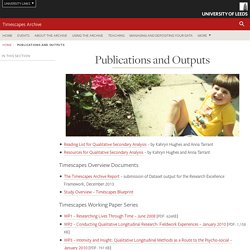
Amazon.co. Review "This dangerous methods book puts Foucault to good work in contesting neoliberal proceduralism and addressing ethically activist research in a critical materialist moment.

" Patti Lather, Ohio State University, emerita" Aaron Kuntz has written a stunning critique of technocratic social science methodology that ignores both its historical and political entanglements as well as its theoretical commitments. He reminds us that methodology is thinkable (or not) only within specific onto-epistemological formations and cannot be applied willy-nilly from one study to another as has become all too common in educational research. Elizabeth A. "Finally we have something to cite when discussing methodologists responsibilities and qualitative inquiry as a political act!
About the Author Aaron M. 13645579.2018. Appreciative Inquiry. "Appreciative Inquiry is about the coevolutionary search for the best in people, their organizations, and the relevant world around them.

In its broadest focus, it involves systematic discovery of what gives “life” to a living system when it is most alive, most effective, and most constructively capable in economic, ecological, and human terms. AI involves, in a central way, the art and practice of asking questions that strengthen a system’s capacity to apprehend, anticipate, and heighten positive potential. " (Cooperrider & Whitney 2005, p.3) Proceedings of the 23rd Western Canadian Conference on Computing Education. Appreciative Inquiry. Linda K Kaye - Google Scholar Citations. Suggestions on qualitative research methods’ articles and books for graduate students. Anybody who has ever read my work knows that I’ve done a lot of research using qualitative methods (even though I consider myself a multi-method scholar).
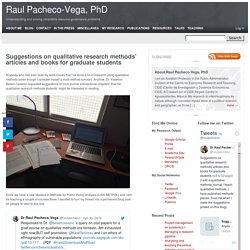
Anyhow, Dr. Yasemin Besen-Cassino requested suggestions of “cool journal articles/book chapters” that her qualitative research methods students’ might be interested in reading. Research Methods in Psychology – Simple Book Publishing. Synthesizing different bodies of work in your literature review: The Conceptual Synthesis Excel Dump (CSED) technique.
Since I’m writing a series of posts on literature reviews (and undertaking a few of my own), I figured I could expand on how you can combine citation tracing, concept saturation, results’ mind-mapping with a method that Professor Elaine Campbell showcases in her excellent post “How I use Excel to manage my literature review“.
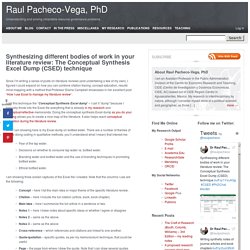
I call this technique the “Conceptual Synthesis Excel dump” – I call it “dump” because I basically throw into the Excel file everything that is already in my research and conceptual/reflective memoranda. Doing the conceptual synthesis Excel dump as you do your reading allows you to create a nice map of the literature. It also helps reach conceptual saturation during the literature review.
What I am showing here is my Excel dump on bottled water. Jbryer/likert: Package to analyze likert based items. Chapter 4 Using Twitter as a Data Source: An Overview of Ethical, Legal, and Methodological Challenges. How Do Research Methods Affect Results? Using Twitter Data to Provide Qualitative Insights into Infectious Di… Uk.sagepub. 학술논문: 10.1633/JISTAP.2018.6.2.4 Content Description on a Mobile Image Sharing Service: Hashtags on Instagram.
Content Description on a Mobile Image Sharing Service: Hashtags on Instagram The mobile social networking application Instagram is a well-known platform for sharing photos and videos.
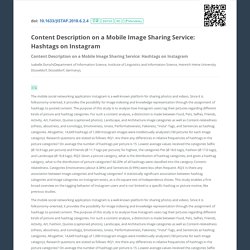
Since it is folksonomy-oriented, it provides the possibility for image indexing and knowledge representation through the assignment of hashtags to posted content. The purpose of this study is to analyze how Instagram users tag their pictures regarding different kinds of picture and hashtag categories. For such a content analysis, a distinction is made between Food, Pets, Selfies, Friends, Activity, Art, Fashion, Quotes (captioned photos), Landscape, and Architecture image categories as well as Content-relatedness (ofness, aboutness, and iconology), Emotiveness, Isness, Performativeness, Fakeness, “Insta”-Tags, and Sentences as hashtag categories. A Phenomenological Research Design Illustrated - Thomas Groenewald, 2004.
Followthehashtag // Twitter Intelligence and Analytics. From zero to hero: Anecdotal tales in pursuit of the elusive doctorate. It's the effect size, stupid: what effect size is and why it is important. It's the Effect Size, StupidWhat effect size is and why it is important Robert CoeSchool of Education, University of Durham, email r.j.coe@dur.ac.uk. Chapter 4 Using Twitter as a Data Source: An Overview of Ethical, Legal, and Methodological Challenges. It's the effect size, stupid: what effect size is and why it is important. How do I know I’m coding well in qualitative analysis? Coding.
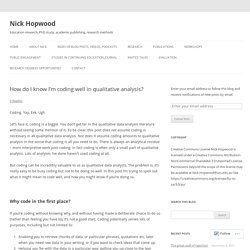
Yay. Eek. Ugh. Let’s face it, coding is a biggie. You don’t get far in the qualitative data analysis literature without seeing some mention of it. But coding can be incredibly valuable to us as qualitative data analysts. Why code in the first place? If you’re coding without knowing why, and without having made a deliberate choice to do so (rather than feeling you have to), it’s not a good start. Enabling you to retrieve chunks of data, or particular phrases, quotations etc, later when you need raw data in your writing, or if you want to check ideas that come up.Helping you ‘be with’ the data in a particular way, getting you up-close to the text. Utilizing Crystallization in Qualitative Methods: Review of Communication: Vol 9, No 4.
It worked there. Will it work here? Researching teaching methods: Ethics and Education: Vol 12, No 3. Durham University Evidence Centre for Education (DECE) : DECE latest news. 'A virtual free-to access journal of 20 years of research by Stephen Gorard' Professor Stephen Gorard has collected together open-access links to some of the hundreds of peer-reviewed journal articles and research reports he has written so far with a range of valued colleagues, in recognition of the increasing number of peer-reviewed papers becoming freely and openly available to all, either because of new journal designs, or because research funders pay for ‘gold’ open access, or university repositories, and of the benefits of such availability of information for potential readers and consumers of research, such as policy-advisers, think tanks, unions and practitioners.
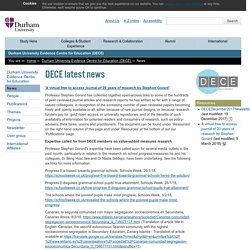
The document can be found under 'Resources' on the right hand column of this page and under 'Resources' at the bottom of out our 'Publications' page. Expertise called for from DECE members on value-added measures research. Another reason to be careful about what you control for. Modeling data without any underlying causal theory can sometimes lead you down the wrong path, particularly if you are interested in understanding the way things work rather than making predictions.

A while back, I described what can go wrong when you control for a mediator when you are interested in an exposure and an outcome. Here, I describe the potential biases that are introduced when you inadvertently control for a variable that turns out to be a collider. A collider, like a mediator, is a post-exposure/post-intervention outcome. Participants’ productive disruption of a community photo-elicitation project: improvised methodologies in practice: International Journal of Social Research Methodology: Vol 20, No 5.
Delphi method. The Delphi method (/ˈdɛlfaɪ/ DEL-fy) is a structured communication technique, originally developed as a systematic, interactive forecasting method which relies on a panel of experts.[1][2][3][4] The experts answer questionnaires in two or more rounds. After each round, a facilitator provides an anonymous summary of the experts’ forecasts from the previous round as well as the reasons they provided for their judgments. Thus, experts are encouraged to revise their earlier answers in light of the replies of other members of their panel. It is believed that during this process the range of the answers will decrease and the group will converge towards the "correct" answer.
Finally, the process is stopped after a pre-defined stop criterion (e.g. number of rounds, achievement of consensus, stability of results) and the mean or median scores of the final rounds determine the results.[5] History[edit] The name "Delphi" derives from the Oracle of Delphi. Key characteristics[edit] Applications[edit] Getting Creative with your Thesis or Dissertation #2. I wrote the first post in this series last summer, not knowing then that there would be another. In that post I highlighted work by doctoral students who have presented their theses or dissertations in various creative ways such as graphic novels or a combination of video and text. I’m grateful to MzOpera for commenting on that post and pointing me to the work of Rebecca Zak from America, who created the first ever entirely web-based PhD dissertation, made up of YouTube videos and blog posts.
Fitting distributions with R. Fitting distribution with R is something I have to do once in a while, but where do I start? A good starting point to learn more about distribution fitting with R is Vito Ricci’s tutorial on CRAN. I also find the vignettes of the actuar and fitdistrplus package a good read. I haven’t looked into the recently published Handbook of fitting statistical distributions with R, by Z. Karian and E.J. Dudewicz, but it might be worthwhile in certain cases, see Xi’An’s review. Phenomenology as Qualitative Research: A Critical Analysis of Meaning Attribution (Routledge Advances in Research Methods): Amazon.co.uk: John Paley: 9781138652811: Books. Review.
Max van Manen. Creative Interviewing - Jennifer Mason. Editorial for Special Edition, Digital RepresentationsSAGE Open - Louise Corti, Nigel Fielding, Libby Bishop, 2016. The collection of papers in this SAGE Open Special Issue on Digital Representations: Opportunities for Re-Using and Publishing Digital Qualitative Data comprise five contributions with a social science or social historical perspective that present the current state of the art in the field of re-using and publishing digital qualitative data. They reference major contributions to the literature and present stimulating debates on the topics.
The articles address the use of digital sources in qualitative research in both research and teaching, charting types of use over the past couple of decades and looking forward to emerging practices and methods. Critical perspectives on the secondary analysis of qualitative data are discussed where relevant across the set of articles, including returning to the ongoing debate over whether or not the “contextualization” of secondary data is essential to enable rich analysis. International Journal of Social Research Methodology. International Journal of Social Research Methodology.